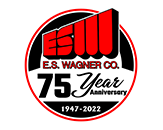INDOT IR-33741-A, Section 4, Segment 8
The construction of approximately four miles of Interstate 69 near Bloomington, Indiana, originally consisted of 3.6 million cubic yards of earthwork. With excavation depths of over ninety feet, embankments reaching over eighty feet and more than one million yards of limestone to be dealt with, the project grading was a massive undertaking. Due to this large volume of limestone, E.S. Wagner established a process on site to size the blasted and excavated rock so that it could be used as rip rap, thereby satisfying more than 90% of the project requirement of nearly 50,000 tons.
Early in the project planning process, E.S. Wagner identified that the majority of the limestone excavation on the north end of the project would have to be hauled over one of the proposed bridges. In order to accomplish this, E.S. Wagner redesigned the bridge over Lodge Road enabling the fifty ton capacity Cat 773 trucks to cross. Going across this structure was the only option to get the limestone from the north end of the project to the large fills on the southern end and using these large capacity off-road haul units was both schedule and cost effective.
There were several construction changes involving the earthwork that E.S. Wagner and the Indiana Department of Transportation collaboratively solved to produce an aesthetically pleasing finish product. In order to maintain the continuity of the project, E.S. Wagner self-performed most of the redesign work. These construction changes added an additional 300,000 cubic yards to the earthwork quantity.
Due to the terrain, thee record years of rainfall, and the fact that the project spanned multiple jurisdictional waterways, erosion control was extremely challenging. In keeping with INDOT’s strict policy on erosion control, E.S. Wagner made sure all of the erosion measures were installed prior to any major activities. This proactive approach to erosion control ensured that sediment was contained and any water that left the site was filtered.
The project had 1.5 miles of drainage pipe ranging in size from 12” to 96”. E.S. Wagner also installed three box culverts ranging in size from 12 ft. x 8 ft. to 20 ft. x 11 ft. The largest box was designed to function beneath the eighty foot embankment near Rockport Road.
E.S. Wagner Company self-performed nine bridge structures comprised of over 4,500 cubic yards of structural concrete. The largest structure was the Harmony Rd. Bridge, which spanned over Interstate 69. Harmony Rd. has three piers, the tallest of which is over ninety feet high. These piers contained over 600
cubic yards of mass concrete, placed in ten mandated pour segments. The challenge with mass concrete is that the core and outside temperatures must be constantly monitored, maintained and, if necessary, adjusted to ensure that they stay within the tolerances specified. Failure to control this differential
could lead to thermal cracking of the structure, which would compromise its function. On this project, E.S. Wagner could stop monitoring the temperatures once the concrete came within fifty degrees of the ambient air temperature. Complying with this difficult criterion was no small task given the elevation of the poured members and the fact that E.S. Wagner performed this work during the winter, with temperatures dropping below zero for some of the placements.
The remaining bridges on the project consisted of six simple spans over active county roads consisting of over 4,300 lf of driven pile and over 48,000 SF of MSE wall panels, as well as a pair of three span bridges spanning a relocated forty wide stream.





